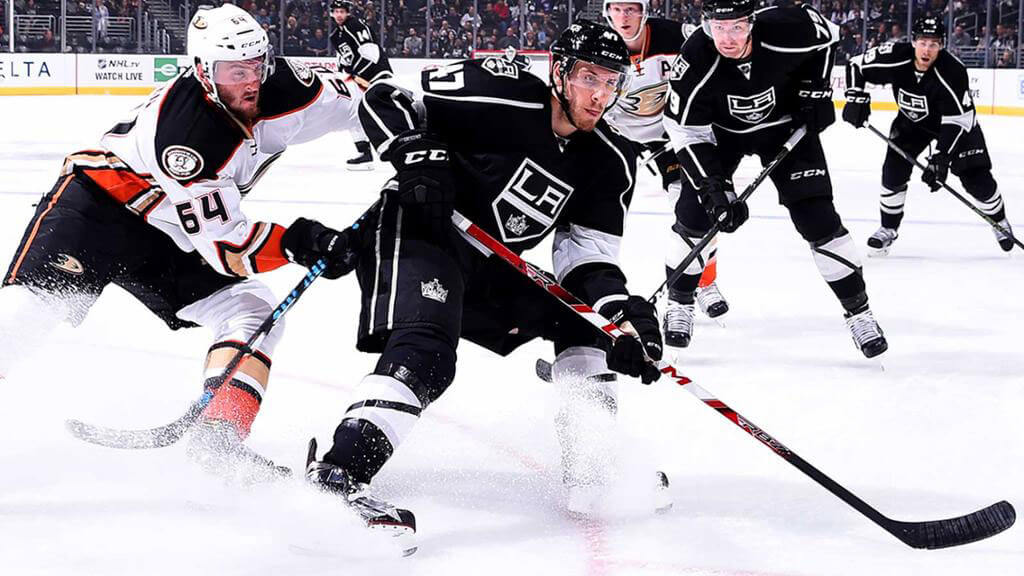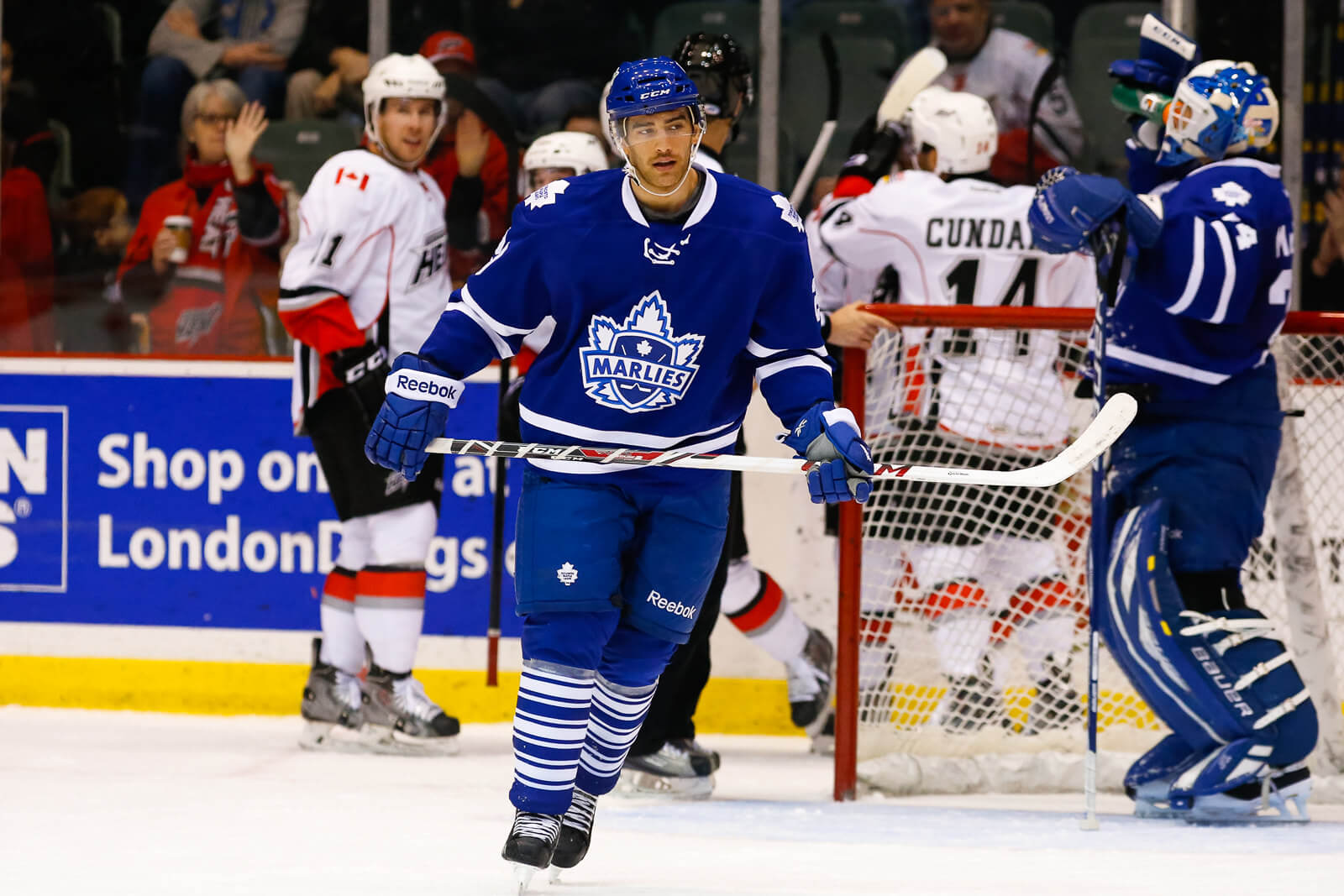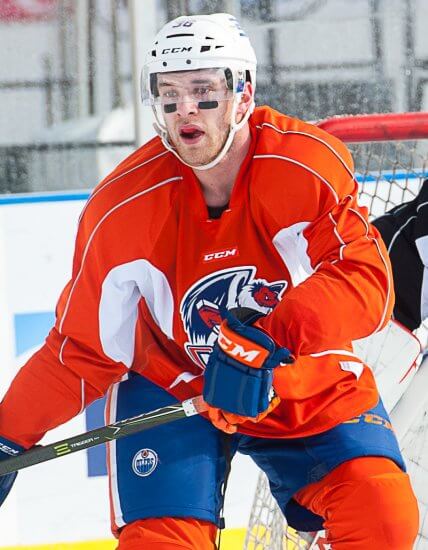Preparing for life after hockey
Former NHLers Andrew Crescenzi and Patrick Russell share how AU helped them prepare for second careers off the ice
Andrew Crescenzi was in his sixth year playing hockey with the Los Angeles Kings organization when serious back injuries cut his season short.
Just a few months earlier, Crescenzi had made his debut in the National Hockey League (NHL). It was an impressive feat considering he was never drafted by an NHL club and had paid his dues playing for the Kings’ farm teams in the American Hockey League (AHL) and, one rung below, the East Coast Hockey League (ECHL). An NHL career was far from certain.
“I always knew that, you know, if I was lucky enough to play hockey for X amount of years that it’s not going to last forever,” says Crescenzi (Bachelor of Management ’20).
The 6-5, 207-pound centre played two games in the NHL before getting sent back to the minors. Later that season, he injured his back but tried to play through it—until, eventually, he couldn’t “move an inch” without extreme pain.

To regain any shot of again playing among the world’s best, Crescenzi needed multiple surgeries to repair herniated discs in two separate areas of his spine. But a lengthy rehabilitation schedule meant he couldn’t attend NHL training camps the following September. So instead, the second-generation Italian-Canadian signed with HC Bolzano, an Italian team in the ICE Hockey League based in Austria.
“I figured I’d go play there for a year and then the next year come back [to North America] once my back was ready,” recalls Crescenzi.
I always knew that, you know, if I was lucky enough to play hockey for X amount of years that it’s not going to last forever. Andrew Crescenzi, retired hockey player
But after playing 36 games with Bolzano, another back injury—and a third surgery in 11 months—ended his season and entire playing career.
At 27, Crescenzi was out of the game that he had played since childhood, forced to figure out what would come next. It’s not an uncommon problem for former hockey players and athletes whose careers ended prematurely or didn’t pan out as planned.
For some, that journey has led to Athabasca University (AU) and using flexible, online learning to draw up a playbook for life after hockey. Graduates like Crescenzi, who now runs his own hockey school, hope that sharing their experiences can inspire others to take a shot at a successful second career.
Quickest route to the NHL
Crescenzi started playing hockey at age three in his hometown of Toronto. Even as hockey became a more serious endeavour, it wasn’t his only focus growing up.
“I was always raised with the belief that education is number 1,” he says.
Starting in Grade 8, his parents made him take courses that could count toward high school credits. It provided some insurance that he would graduate on time in case he made it to major-junior—a level of competition and commitment to a game that would demand sacrifices for everything else, including studying.
I was always raised with the belief that education is number 1.
At age 16, he was drafted by the Kitchener Rangers of the Ontario Hockey League (OHL)—a major step toward realizing his NHL dream and following in the footsteps of his Toronto Maple Leafs’ idol, Doug Gilmour.
While some players opt to play at the college level through the National Collegiate Athletic Association (NCAA) and earn a degree, at the time, in 2010, “The quickest path to the NHL, for me, was the OHL.”
“I always knew that, OK, if I do play in the OHL, I am giving up the opportunity to go play NCAA hockey and get my degree,” Crescenzi says. “But I knew that I would go back to school once I was retired. A lot of people will never do that.”

Hockey comes first
Like all Canadian major-junior leagues, the OHL has an education program to ensure that sport isn’t the only focus for players. (In fact, the Western Hockey League has such a program and AU is one of its educational partners.) Players get access to educational advisors, tutors, and university and college scholarships. Finding time and motivation to study, however, was a challenge for Crescenzi.
“You’re constantly at the rink training or you’re doing your office training or you’re on a bus or you’re on a plane travelling,” he explains. Thanks to his parents’ foresight, the teen graduated high school on schedule with his peers.
The 2010 NHL draft came and went without anyone calling Crescenzi’s name, but it wasn’t long before the Toronto Maple Leafs invited the 18-year-old to training camp on a tryout. He impressed enough to earn his first pro contract.
Related: WHL players, alumni score through league’s partnership with AU
From then on, hockey was the only focus as Crescenzi tried to climb the professional ranks in the Maple Leafs’ and then the Kings’ farm systems. He was driven by the awareness that his spot in the lineup was anything but secure. You’re always a few bad plays away from sitting in the press box or getting sent back to the minors.
“It’s very cutthroat,” he says. “You kind of have to come to terms with that before you get into that profession.”
University life interrupted
Like Crescenzi, AU learner Patrick Russell credits his parents for keeping him grounded while pursuing hockey at increasingly competitive levels. But instead of following the major-junior route to the NHL, the Danish hockey player from Copenhagen went through a university campus and the NCAA.
Russell was a student-athlete at Minnesota’s St. Cloud State University where he studied management. During his rookie year, he was named to the National Collegiate Hockey Conference’s academic all-star team, which recognizes student-athletes with a grade point average of 3.0 or better.
“My parents always pushed me, told me how important school was and the ability to learn new things,” remembers Russell. “I think that’s really important.”
But even with those values instilled in him, Russell wasn’t immune to the NHL dream and the possibility of earning millions to play a game while enjoying all the perks of professional sport.
As a player, he stood out for his mix of size and power. The 6-1, 205-pound right winger scored 66 points in 81 games during his college career. In his second year, he helped the St. Cloud State Huskies win a conference title.
Russell’s talent and physical attributes attracted the attention of several NHL clubs, including the Edmonton Oilers. So in 2016, at age 23, he left school after his sophomore year to sign a two-year contract with the Alberta-based NHL club.
“It was a really tough decision, but I took the decision based on what is best for my development as a player,” Russell said at the time.
View this post on Instagram
Following the NHL dream at all costs
It’s not uncommon for players like Russell to leave school before finishing a degree. A 2018 Washington Post article noted that 30 per cent NHL players went to college for at least one season. Of that total, 71 per cent played at least three seasons before giving into their NHL ambitions and turning pro.
Leaving school for a shot at the NHL is a gamble, even if you make it. The minimum salary of $750,000 USD is large compared to most professions, but the average NHL career is just five years.

Players who don’t make it to the NHL earn substantially less. Minimum salaries in the AHL are $51,000 USD while the minimum for rookies in the ECHL is $500 per week—which rises by $45 for returning players.
Russell ended up playing parts of three seasons with the Oilers organization, most of it in the AHL with the Bakersfield Condors. He played a career-high 45 games with the Oilers in 2019-20 but got into just eight games the following pandemic-shortened season.
As a free agent this past summer, Russell signed a two-year contract with Linköping HC of the Swedish Hockey League. That’s when he started thinking about the future and continuing his education, which led him to discover AU.
“I’m 29 now, so I don’t have 20 years left in hockey,” says Russell. “You just never know what happens with hockey. You always need to have a backup plan.”
Helping players enhance their career prospects
Steven Carney’s job is to help players like Russell figure out their next steps through the Professional Hockey Players Association (PHPA), the union that represents AHL and ECHL players and alumni.
Carney runs the PHPA’s career enhancement program, which connects players with education partners like AU, and with professions such as firefighting or the skilled trades. The program also offers service such as career counselling, resumé writing, and job interview preparation.
“We try and educate guys on what’s next,” he explains.
A lot of these guys, if they were given the choice, they’d love to stay in the game. Steven Carney, Professional Hockey Players Association
For 98 per cent of players, Carney says, hockey has been the only thing they’ve known since they were four years old and just starting to skate.
“A lot of these guys, if they were given the choice, they’d love to stay in the game,” as a coach or scout, he says. “But again, there’s only so many jobs available.”
COVID-19 adds even more uncertainty
Before the pandemic, Carney said about three-quarters of the 200-plus players who access the career enhancement program each year played in the ECHL—a figure that perhaps makes sense given the lesser salaries and modest career prospects of the league’s players. Since the pandemic, however, there’s been a surge of interest among AHL players and alumni who’ve seen their livelihoods disrupted with shortened seasons.
“You think about the veteran guys that might be in their early thirties, and they were counting on a couple more big contracts going down the stretch [of their career],” Carney says. “All of a sudden, those contracts are not there.”
NHL players are not immune to such feelings of anxiety, Russell says, especially when a player knows retirement is drawing near.
“They don’t think they don’t have any skills. They don’t have an education, they don’t have a work history, so they’re really panicked and in a dark place.”
The AHL Board of Governors has voted to cancel the remainder of the 2019-20 AHL regular season and the 2020 Calder Cup Playoffs due to the ongoing COVID-19 public health crisis.
→ https://t.co/b8XoXIimHE pic.twitter.com/G1fafFhJHV
— American Hockey League (@TheAHL) May 11, 2020
Online education sets up winning future
Russell chose AU with an eye toward a career in business, although he says nothing about his second chapter is set in stone. One of the advantages of online learning, he adds, is the flexibility to finish as many or as few courses as his playing schedule allows—which is extra important this season since he is also representing Denmark at the Beijing 2022 Winter Olympic Games.
“Sometimes, like if on a road trip or whatever, there’s a lot of time on the bus to do some homework,” he says. “It gives me something to do and work at my own pace towards getting a degree.”
Crescenzi says he started thinking about the future after suffering his second back injury. “It was like a light bulb clicked.”
There’s a lot of time on the bus to do some homework. It gives me something to do and work at my own pace towards getting a degree. Patrick Russell
He opted for AU, he says, because he could fit online learning around his hectic hockey schedule and didn’t have to sit in class. He chose the Bachelor of Management program because his family was business oriented.
“I always knew that I wanted to do something in business, I just didn’t know what that was exactly.”
It turns out Crescenzi also has the family’s entrepreneurial flair. Since earning his bachelor’s degree, he opened his own business: Crescenzi Pro Hockey. The Toronto-area hockey school helps players develop on-ice skills and off-ice maturity.
Running the school allows him to combine his knowledge and passion for the game and what he learned at AU. In fact, he has enjoyed the experience so much, Crescenzi enrolled in an after-degree education program with plans of being a grade-school teacher.
His advice to up-and-coming players is simple: focus on school, and do it early. “Get your degree so you don’t have to worry about it after you’re done,” he says.
Perhaps the biggest lesson he learned is that hockey and learning can follow the same path, even if it took him a while to figure out.
“Education was very important growing up, and then there was a phase where I didn’t really think much about it,” he says. “And now it’s a big part of my life again. It is full circle.”
View this post on Instagram
AU, Professional Hockey Players Association celebrate 10 years of partnership
AU and the Professional Hockey Players Association have reached a new milestone in a winning partnership.
For the past 10 years, AU has worked with the association as one its educational partners. Current and former players of the American Hockey League and the East Coast Hockey League can take courses through AU to prepare for the next stage of their life after hockey.
“Athabasca University has been a phenomenal partner and flexibility is a big part of it,” says Steven Carney, who runs the association’s Career Enhancement program. “The monthly start dates of courses and being 100% online, that flexibility has worked really well for many of our guys.”
Almost 70 players and alumni have completed more than 330 AU courses during the span of the partnership.
“I’m honoured to have worked with the Professional Hockey Players’ Association for the past decade. As one of AU’s longest partnerships, it’s been a pleasure to grow together,” said Michael Shouldice, manager of partnerships and collaborations at AU. “We each serve their members, who are working to advance their hockey careers and post-secondary education simultaneously. AU’s open, online and flexible delivery model means that neither needs to be sacrificed for the benefit of the other.”